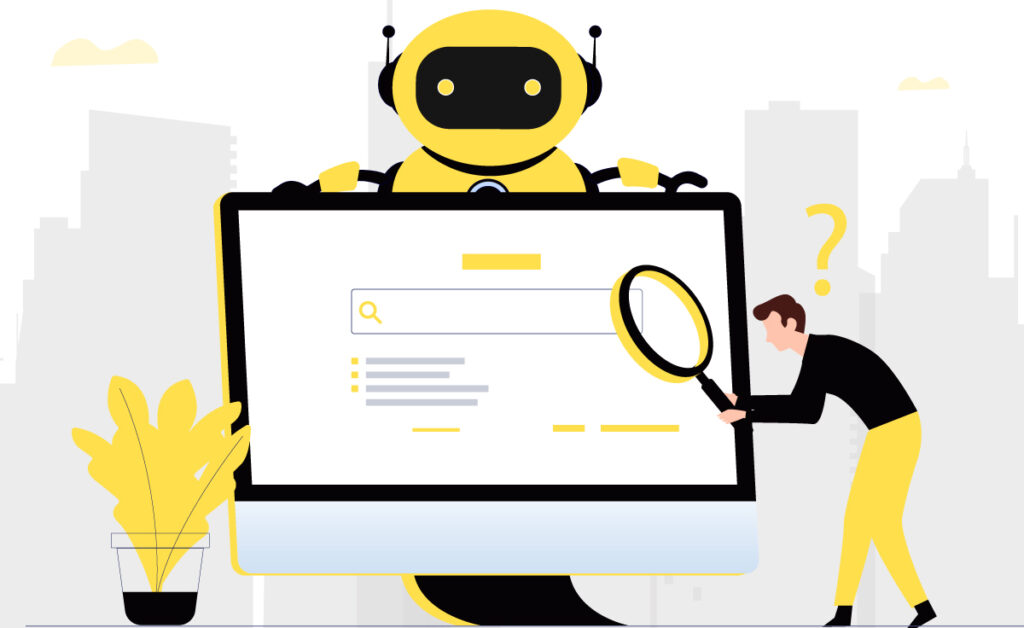TL;DR:
- AI-generated content often feels flat, generic, and disconnected because it lacks voice, perspective, and real human context that readers and search engines reward
- Common AI failures include repetitive phrasing, robotic tone with no rhythm, equal weight on all points, and vague statements without specific examples
- Start by scanning the draft to understand its main point before making any edits
- Always fact-check stats, sources, and claims as AI can sound confident even when wrong
- Rewrite the intro and conclusion to sound like your brand, address reader pain points, and provide clear takeaways
- Add unique insights only your brand can provide: customer stories, your own data, or expert opinions
- Break up monotonous text with subheads, bullets, and varied paragraph lengths to improve readability
- Read the content aloud to catch awkward, robotic phrasing that your eyes might miss
- Test if content is “human enough” by checking if it has attention-grabbing sentences, shows expertise beyond industry basics, and would be valuable even without SEO
- The best approach combines AI for speed with human editors for clarity, context, and credibility that actually connects with audiences
Introduction
Before we answer that question, let’s clarify what we mean by AI content and what we mean by humanizing it.
When we say AI content, we don’t mean text flagged as “AI-written” by popular detection tools. Those tools often hallucinate and misjudge perfectly fine writing, so they shouldn’t be your benchmark for authenticity. What we’re talking about is content generated with a few quick prompts, the kind that skips any real involvement from a writer, editor, or content agency. If you’ve tried this, you already know what that first draft feels like. It’s technically fine, but somehow off. There is no voice, no point of view, nothing that sounds like a real person wrote it.
And that’s a problem. Readers can tell. They scroll right past content that feels generic. Search engines can tell too; they’re rewarding originality, clarity, and authority over sheer volume. Humanizing your AI content changes that. It gives your words rhythm, perspective, and connection. It makes your brand sound like it’s coming from someone who actually knows what they’re talking about and not just a model repeating what’s already been said. Because in 2025, content has to do more than fill a page and include keywords. It has to feel real enough to earn attention and trust.
This guide is for when you’ve got that AI draft and know it’s not ready. We’ll show you how to turn it into something human, relatable, and genuinely effective.
Why You Need to Humanize AI Content?
Humanizing AI content isn’t about hiding the fact that you used it; it’s about making sure the final result sounds like something your audience will actually trust. Most AI-generated content isn’t bad because it’s artificial. It’s bad because it feels vague, impersonal, and disconnected from what people are actually looking for.
That’s what humanizing fixes.
According to the Content Marketing Institute, 71% of marketers using AI say they still rely on human editors to get quality right. And it shows, the teams that combine AI with solid editorial processes consistently see better rankings and engagement than those relying on raw output alone.
But here’s the part most blogs skip: humanizing isn’t just editing for grammar or tone. AI gets that correct pretty much every time. It’s about adding context, examples, and clarity that only someone with real experience would think to include. It’s also about removing what doesn’t need to be there, the fluff, the filler, the stuff AI adds to hit a word count, not a purpose.
AI is great at generating content quickly, but it misses the mark in some pretty familiar ways.
Where AI Usually Fails?
First, the writing often feels flat. The pacing is too even, the sentences too clean. There’s no variation or rhythm, nothing that sounds like a real person thinking through a point or reacting naturally to the topic.
You’ll also notice it repeats itself. The same idea might show up two or three times in slightly different words. It’s not intentional. AI just isn’t great at deciding what’s worth saying once and what can be cut.
Then there’s structure. Sure, it knows how to format a blog post. But everything gets equal weight. It won’t slow down to dig into what really matters, or speed through the obvious stuff. You’re left with content that technically covers the topic, but doesn’t guide the reader through it in a useful way.
Tone is another weak spot. Even if you ask for a casual or conversational voice, it often sounds generic. Not wrong, just not very human. It doesn’t reflect your brand, and it doesn’t feel personal.
All of that adds up to content that looks fine at first glance, but doesn’t connect. That’s why you need someone to step in, tighten the message, and give it a voice your audience actually relates to.
A Step-by-Step Process to Humanize Content
If you’ve got an AI draft but it still feels off, here’s how to fix it, step by step:
1. Start by scanning, not editing
Don’t jump straight into fixing sentences. Read the draft once without touching anything. Ask yourself: What’s the point of this? Is there a clear takeaway? If you can’t sum it up in one line, the content needs more focus before you worry about the wording.
2. Fact-check as you go
AI has a habit of sounding confident, even when it’s wrong. Stats might be outdated, sources could be vague, and “best practices” might be recycled fluff. Double-check names, numbers, tools, and timelines, especially in fast-changing industries like marketing, tech, or finance.
3. Rewrite the intro and outro
AI-generated openings are usually too formal, too generic, or both. Start your piece like a person would: get to the point, discuss the reader’s pain points, show why it matters, and make it sound like your brand. Same for the ending, aim to leave the reader with a clear takeaway, not a summary of what they just read.
4. Add something only your brand could say
This is where most AI content falls flat. Bring in a customer insight, a data point from your own platform, or even just your opinion. It doesn’t have to be revolutionary; it just has to sound like your brand. That’s what builds trust and signals originality.
5. Break up the sameness
If the whole post is one long wall of paragraphs, no one’s getting through it. Use subheads to reframe sections, add bullets or numbered lists where they make sense, and sprinkle in transitions that help the content flow.
6. Read it out loud
This is the simplest and most effective trick. If it sounds awkward, robotic, or too perfect, it probably needs rewriting. Real writing has rhythm, and your ears will catch problems your eyes miss.
Also Read: What Does Google Think of AI Content and 6 Best Practices for Using AI Content
Real Examples: Before vs. After Rewriting AI Content
Here are two examples that show how important context is while writing content for your website.
“The brief: The content is meant for entrepreneurs and small business owners in Tier 2 and Tier 3 cities. This is for sellers who may be new to e-commerce but are interested in expanding their business online. They may be hesitant due to a lack of technical expertise, resources, or prior exposure to digital selling.”
AI-written content:

Human written:

At first glance, both seem well-structured and informative. However, a closer look reveals the real difference: context and connection. AI-generated content sounds polished and is factually correct, but it uses formal phrases like “navigating the intricacies,” which the target audience may not instantly relate to. The data it shares lacks context and the facts are presented without explaining why they matter to the reader.
In contrast, human-written content feels friendly and conversational. It understands the needs of small-town sellers, and offers reassurance and clear guidance in a relatable, engaging way.
Let’s say you’re working on a blog post for a B2B SaaS client; it needs to explain the product, offer some actual value, and not bore the reader into closing the tab.
Here’s what you might get from your AI tool:
AI-Generated (Before)
Time-tracking software is an essential tool for increasing employee productivity. By using real-time data and automated reports, businesses can better manage their teams and ensure efficient project delivery. Time tracking also provides valuable insights into resource allocation and performance metrics.
It’s not wrong. But it’s forgettable. You’ve seen this kind of writing a hundred times; it says the right things, but it doesn’t say anything new. No personality, no point of view, no hook.
Now here’s how that same section might look after a human editor reworks it:
Human Rewrite (After)
If your team is spending more time updating spreadsheets than doing actual work, time-tracking isn’t a nice-to-have; it’s non-negotiable. The right tool shows you where time’s really going, flags the slowdowns, and helps you lead smarter without micromanaging.
Why does the rewrite work better?
- The first line doesn’t talk about “productivity” in the abstract; it calls out something your reader’s actually tired of: wasting time updating spreadsheets.
- It shows value without listing features. Instead of saying “automated reports,” it gives context: this helps you spot slowdowns and manage without hovering.
- It sounds like someone with a point of view. “It’s non-negotiable” isn’t just filler; it adds energy, like the writer is confident in what they’re saying.
- It’s clearer, faster, more useful and respects the reader. You don’t have to read it twice to get the point.
Bonus Checklist: Is This Content Human Enough?
If you’re using AI in your content pipeline, ask these before anything goes live:
1. Is there any sentence in this piece that caught your attention?
If the whole draft feels like a safe, predictable rehash of what’s already out there, your reader will feel it too. Add a stat, a sharp line, or a takeaway that makes someone pause or scroll back up.
2. Can you tell why this was written and who it’s for, within the first 30 seconds?
If the intro could apply to five other blog posts, rewrite it. Your opening should frame a specific problem for a specific person. Not everyone, your reader.
3. Does it show, not just tell?
AI loves sweeping statements: “Time-tracking boosts productivity.” It’s not wrong, it’s just incomplete without real examples or data. Use a customer example, a result from your campaign, even a strong metaphor, anything that grounds the point in reality.
4. Does the content reflect your company’s actual expertise, or just industry basics?
AI is good at summarizing the internet. Your edge is what you actually know: how your customers behave, what failed last quarter, what trend you spotted early. If that’s missing, the human layer is too thin.
5. Does the tone shift from section to section?
One of the easiest tells of AI-generated (or multi-tool-stitched) content is tonal inconsistency. Fix any sudden formality or weirdly chirpy lines. The voice should feel consistent, like one person wrote the whole thing with a clear head.
6. Would this still be valuable if it didn’t rank?
This is the real test. Strip away the keyword, the H1, the metadata, would you still want to send this to a client or prospect? If not, it’s SEO scaffolding, not content.
Conclusion
AI may have changed how content gets made, but the real difference still comes from clarity of thought, smart storytelling, and a strong editorial hand. Great content doesn’t just fill a brief; it builds credibility, trust, and performance.
At Justwords, we help brands bring that balance together. Whether your starting point is a raw idea, an AI draft, or a complete strategy, our team ensures the final piece sounds authentic, reads with purpose, and delivers real results.
If you’re ready to create content that works harder for your brand, let’s talk.
Frequently Asked Questions
Can we use AI to help with updating old content, or should that always be manual?
You can absolutely use AI to speed up content refreshes (e.g. rephrasing, summarizing outdated sections), but human editors should still fact-check, add new insights, and make sure the tone still fits your brand.
How do we explain AI-assisted content to internal stakeholders who are skeptical?
Be transparent about what AI does and doesn’t do. Show how it speeds up first drafts, not final outcomes. Walk them through a before-and-after edit to prove the human layer is what makes it publish-worthy.
Should we be worried about copyright or plagiarism with AI tools?
Yes. Most mainstream tools generate original wording, but they’re trained on huge datasets that may include protected content. Always run outputs through plagiarism checkers and avoid publishing anything that feels overly derivative or too close to source material.





